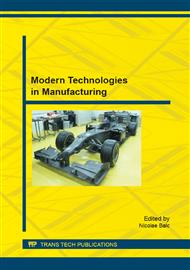p.327
p.333
p.339
p.345
p.353
p.359
p.364
p.370
p.376
Ways of Increasing the Productivity in a Job-Shop Production Company
Abstract:
The necessity of increasing the products competitiveness is one of the main requests valid for the small and medium enterprises. A better adaptation of the companies to the needs of a market in a continuous change determined the enterprises to search and apply new technological and managerial solutions. Thus, a decrease of the manufacturing costs by diminishing the operational times due to the use of a better disposal of the machine tools in the mechanical workshop could be considered. The analysis led to the conclusion that distinct methods could be applied in order to establish an improved disposal of the machine tools, so that a higher flexibility and adaptability of the production to the requests of manufacturing of various parts is ensured. An optimization method based on the analysis of operation times on each of machine tools was appreciated as able to fulfill the needs of increase the work productivity. By taking into consideration empirical concerns some calculus for total durations of technological operations and some distinct ways of wokpieces movements in the mechanical workshop was approached. Thus, in a case study, a new disposal of the machine tools within workshop was proposed and analyzed.
Info:
Periodical:
Pages:
353-358
Citation:
Online since:
November 2015
Price:
Сopyright:
© 2015 Trans Tech Publications Ltd. All Rights Reserved
Share:
Citation:


